|
|
|
Sort Order |
|
|
|
Items / Page
|
|
|
|
|
|
|
| Srl | Item |
| 1 |
ID:
143302
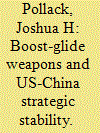

|
|
|
|
|
| Summary/Abstract |
The United States and China are testing boost-glide weapons, long-range strike systems capable of flying at Mach 5 or faster through the upper atmosphere. For the United States, these systems would provide a conventional prompt global strike capability, which, together with US ballistic missile defense programs, Chinese experts regard as a threat to China's ability to conduct nuclear retaliation. This perception is encouraging the Chinese military to modify its nuclear posture in ways that tend to create greater risks for both sides. If China's own boost-glide systems are meant to carry nuclear payloads only, their deployment would not fundamentally alter the current situation between the two states. However, if they were conventionally armed or dual-purpose, or if the United States could not determine the payloads they carried, the deployment of Chinese boost-glide systems could compound problems of strategic stability created by the introduction of ballistic missile defense, antisatellite, and antiship ballistic missile capabilities. If the technical hurdles can be overcome, it may be difficult for the two sides to refrain from these deployments in the absence of strong mutual trust or an established arms-control relationship. New confidence-building measures and expanded mutual transparency are warranted to avoid creating new dangers.
|
|
|
|
|
|
|
|
|
|
|
|
|
|
|
|
| 2 |
ID:
128749
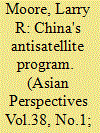

|
|
|
|
|
| Publication |
2014.
|
| Summary/Abstract |
I analyze the substance and goals of China's antisatellite program. Following China's 2007 antisatellite test that successfully destroyed one of its aging satellites, signs have emerged that China is continuing to research ways to exploit the heavy US reliance on space. This capability is most likely being developed as an "assassin's mace" to gain an advantage against a technologically superior enemy in the event of conflict. I propose a number of countermeasures to negate the threat to US space security
|
|
|
|
|
|
|
|
|
|
|
|
|
|
|
|
| 3 |
ID:
005975


|
|
|
|
|
| Publication |
Washington, National Defence Univ. Pr., 1990.
|
| Description |
230p.
|
|
|
|
|
|
|
|
|
|
|
|
Copies: C:1/I:0,R:0,Q:0
Circulation
| Accession# | Call# | Current Location | Status | Policy | Location |
| 037545 | 355.4/GIL 037545 | Main | Withdrawn | General | |
|
|
|
|
| 4 |
ID:
130002
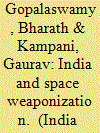

|
|
|
|
|
| Publication |
2014.
|
| Summary/Abstract |
Since China tested a Kinetic-Energy Anti-Satellite (KE-ASAT) weapon in 2007, evidence has surfaced that India may have initiated a similar program. This article makes an anticipatory policy intervention against the development of KE-ASAT weapons. It presents data to show that space debris, and not KE-ASAT weapons, pose the highest risk for the safe operation of Indian satellites. It models a KE-ASAT weapons exchange between India and China in three different scenarios to demonstrate that use of such weapons even on a limited scale would produce an exponential increase in space debris. The latter would threaten the safe operation of satellites for all countries concerned. These data suggest that the concept of deterrence as understood in conventional and nuclear spheres is not easily transportable to the domain of space weapons, which threaten the physical destruction of satellites. If weaponization of space becomes inevitable, policy makers would be better off investing in weapons that disable but do not physically destroy satellites.
|
|
|
|
|
|
|
|
|
|
|
|
|
|
|
|
| 5 |
ID:
171174
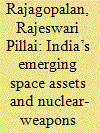

|
|
|
|
|
| Summary/Abstract |
Over the last five decades, India’s nuclear and space programs have gone through several phases, from collaboration to divorce to supportive. An interplay of two factors determined the nature of the relationship. One was the state of India’s nuclear-weapon program. The second was international conditions, especially India’s relationship with the nuclear-nonproliferation regime. In the early decades, because of the rudimentary nature of India’s nuclear and space programs, the relationship was collaborative, since the rocket technology being developed was a necessary adjunct to the nuclear-weapon program. Subsequently, as India’s rocketry capabilities and nuclear-weapon program began to mature and concerns about international sanctions under the non-proliferation regime began to grow, the two programs were separated. The Indian rocketry program was also divided, with the civilian-space and ballistic-missile programs clearly demarcated. After India declared itself a nuclear-weapon state in 1998 and the programs matured, the relationship has become more supportive. As the two programs mature further, this relationship is likely to deepen, as the nuclear-weapon program requires space assets to build a robust and survivable nuclear deterrent force.
|
|
|
|
|
|
|
|
|
|
|
|
|
|
|
|
| 6 |
ID:
169304
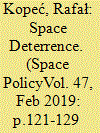

|
|
|
|
|
| Summary/Abstract |
The development of the antisatellite (ASAT) weapons is a crucial process of the second era of space militarization. As a result, outer space loses the status of a sanctuary. However, this process does not steam only from the technological advance but also from strategic circumstances. The increasing number of space actors makes the system less stable. The degree of dependency on space assets is significantly different in different countries, what creates the vulnerability gap. What is more, the capability to defend a space infrastructure is profoundly limited due to physical and technological limitations, favoring offensive actions. Outer space is turning into offense-dominant domain.
|
|
|
|
|
|
|
|
|
|
|
|
|
|
|
|
| 7 |
ID:
155205
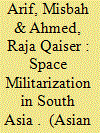

|
|
|
|
|
| Summary/Abstract |
India’s quest for space weaponization will have consequences for regional stability. South Asia remains a precarious region given the historical rivalry between India and Pakistan and their posture of mutual deterrence. India’s pursuit of space weaponization and subsequent militarization will trigger an expensive and unnecessary arms race between India and Pakistan, exacerbating the fragility of the South Asian security matrix.
|
|
|
|
|
|
|
|
|
|
|
|
|
|
|
|
| 8 |
ID:
169298
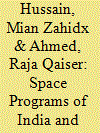

|
|
|
|
|
| Summary/Abstract |
Outer space can be used for military and strategic purposes. The growing dependence of militaries on outer space assets in pursuit of operational and communicational undertakings make them productive assets and plausible targets for adversaries. Such threats push the states to take measures to secure their space assets. India is developing its dedicated military satellites for Command, Control, Communications, Computers, Intelligence and Surveillance (C4ISR) capabilities. The progress in military assets in outer space, Ballistic Missile Defense (BMD) system, antisatellite weapons, surveillance, and intelligence capabilities are a major concern for Pakistan. Strategic stability in South Asia is under question, and there is a need to analyze the changing security dynamics of the region. This article provides a detailed overview of India's recent development on BMD system and other space assets of India and Pakistan. The emerging technologies will have serious implications for strategic stability in South Asia. This article is an attempt to understand the potential security scenarios between India and Pakistan and concludes that the technological asymmetries may lead to strategic instability.
|
|
|
|
|
|
|
|
|
|
|
|
|
|
|
|
|
|
|
|
|